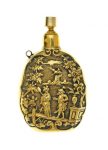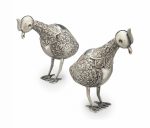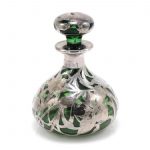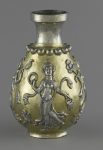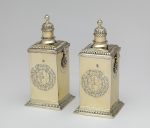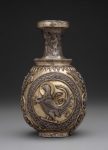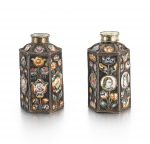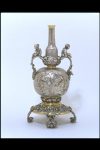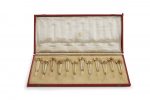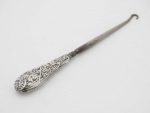Scent bottles / perfume bottles have been made and decorated with silver for many years. They have been used for holding wine, scent, snuff and many other substances. Below are some examples of scent bottles either made of or decorated with silver.
A late 17th century silver-gilt scent bottle unmarked, English circa 1690 Flask-shaped with a screw-on cover and screw-on finial, both sides with chinoiserie scenes, height 7cm, weight 60gms.
Sold for £ 2,500 inc. premium at Bonhams in 2018
Lidded cylindrical silver case for a glass scent bottle (the original glass bottle still remains inside). It is decorated with floral decoration throughout and with a central hunt scene – a boar being attacked by two hounds and on the reverse, an elephant fighting a tiger. An armorial shield that bears the name ‘Mrs. Craig’ is visible above the boar-hunt scene. A latch at the base secures the bottle; the lid is secured with a screw mechanism. Workshop of: Oomersee Mawjee circa 1890-1910
Reference: © The Trustees of the British Museum
A PAIR OF PERFUME BOTTLES IN THE FORM OF BIRDS POSSIBLY KUTCH, NORTH OR WEST INDIA, LATE 19TH/ 20TH CENTURY Modelled as birds, their necks and wings with chased and embossed decoration comprising smaller birds in flight or perching amidst scrolling floral vines, engraved tuft of feathers on the crown of their heads each 8 in. (20.3 cm.) high
Sold for USD 6,875 at Christies in 2018
Victorian Sterling Silver and Ruby Glass Figural Perfume Bottle Edward Barnard, John Barnard & William Barnard, London, circa 1870 Height 6 inches.
Sold for $562 (includes buyer’s premium) at Doyle New York in 2017
Green perfume bottle featuring a silver flower overlay. Overlay wraps around top as well. In overall good condition consistent with age. Measurements: 4 3/4″ tall x 3 3/4″ wide
Sold for $325 at Market Auctions Inc. in 2019
This gilded silver bottle decorated with elegant female dancers is typical of Sassanid metalwork. It hints at the sumptuous luxury of royal and religious feasts during the Sassanid era. Sassanid art was heavily influenced by the traditions of antique Greece, Rome, and Iran. In turn, it was an important influence on the art of medieval Europe. Sassanid fabrics and silks in particular were widely copied.
Reference:The Louvre
Pair of perfume bottles Maker:John Bodington (British, active 1688–1727) Date:1700/1
The engraved arms on these perfume bottles are beautifully preserved. Even the delicate circle traced by the engraver as a compositional aid has not worn off. The system of indicating colors or tinctures in the arms had not been widely adopted yet, so these arms cannot be securely identified. The bottles were part of a large silver dressing-table service that would have included a mirror, combs, brushes, and boxes for powder and pomade—all the necessary implements for grooming.
Reference: The Metropolitan Museum of Art
Bottle with roosters Near Eastern, Iranian, Persian Sasanian A.D. 226–651
Silver bottle with mercury gilding, decorated with images of roosters and flowering plants. Roosters are here symbols alluding to monarchy and Zoroastrian notions of spiritual awakening. hey are shown wearing the royal necklace and enveloped by the royal halo.
Reference: Museum of Fine Arts Boston
A pair of silver and enamel scent bottles, Solvychegodsk, circa 1700 hexagonal, one decorated with birds, the other with flowers and two portraits Quantity: 2 height 8cm, 3 1/8 in.
Sold for 35,000 GBP at Sothebys in 2018
A perfume bottle, intended for display. Design & Designers This bottle was made by the renowned French silversmith Frédéric-Jules Rudolphi and was exhibited at the Exhibition of Industrial Art, held in Paris in 1844. As with many of his contemporaries, Rudolphi was particularly interested in surface treatment, and this vase is oxydised and parcel-gilt (partly gilded). Rudolphi’s designs were eclectic, drawing on a number of stylistic sources that included Oriental, Renaissance and Gothic art.
Reference: © Victoria and Albert Museum
